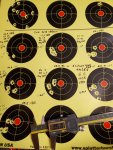Shot at 100 off a bipod and bag. 77 tmk and 8208 xbr in 16" barrel .1 grains apart weighed with chargemaster 1500. Which one you going with? Info on targets. Maybe someone sees something I dont.

Also shot the same setup with 77 grain nosler blems from sps grouped like shit. 2-3 inch groups in scattered pattern.

Also shot the same setup with 77 grain nosler blems from sps grouped like shit. 2-3 inch groups in scattered pattern.

